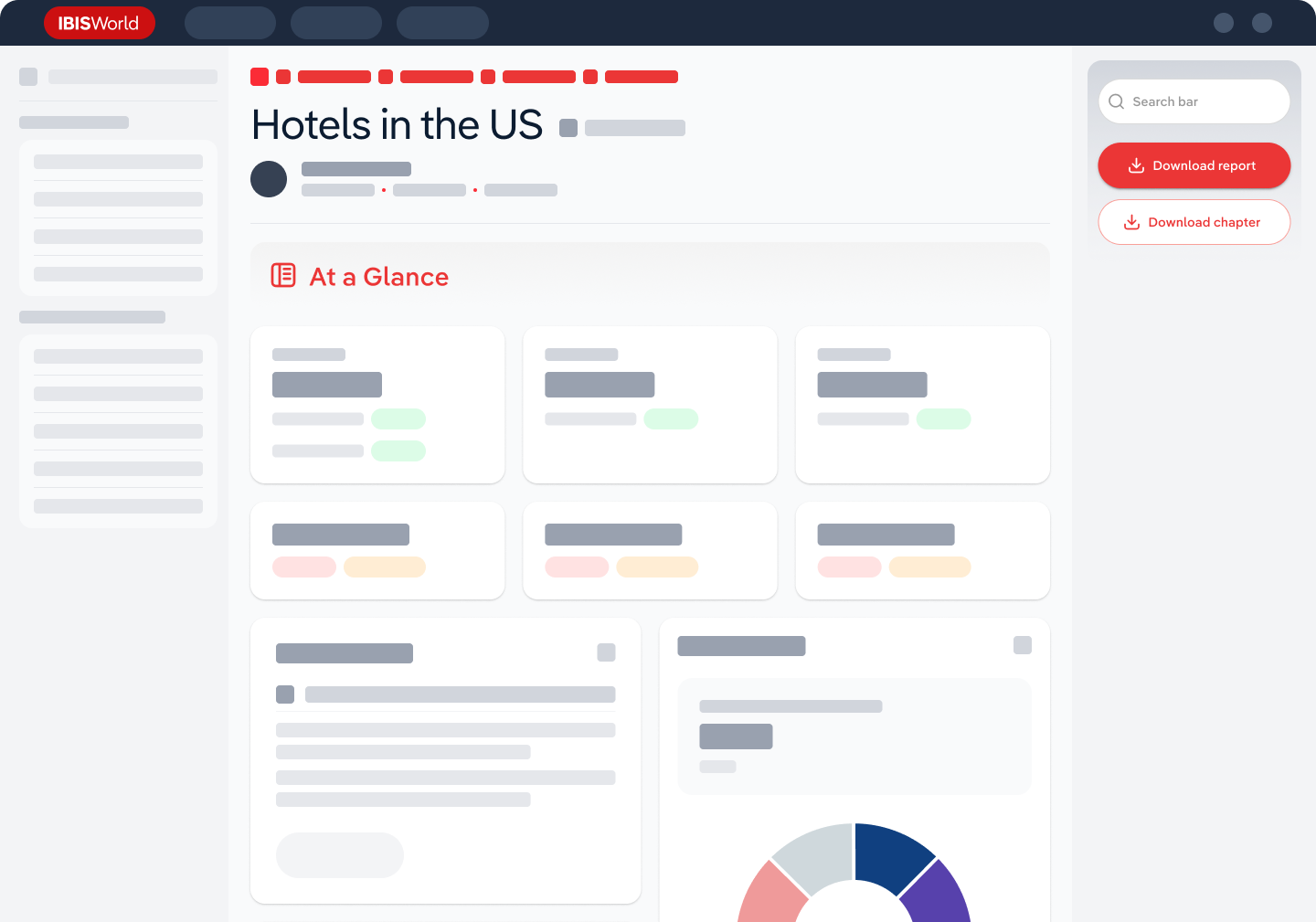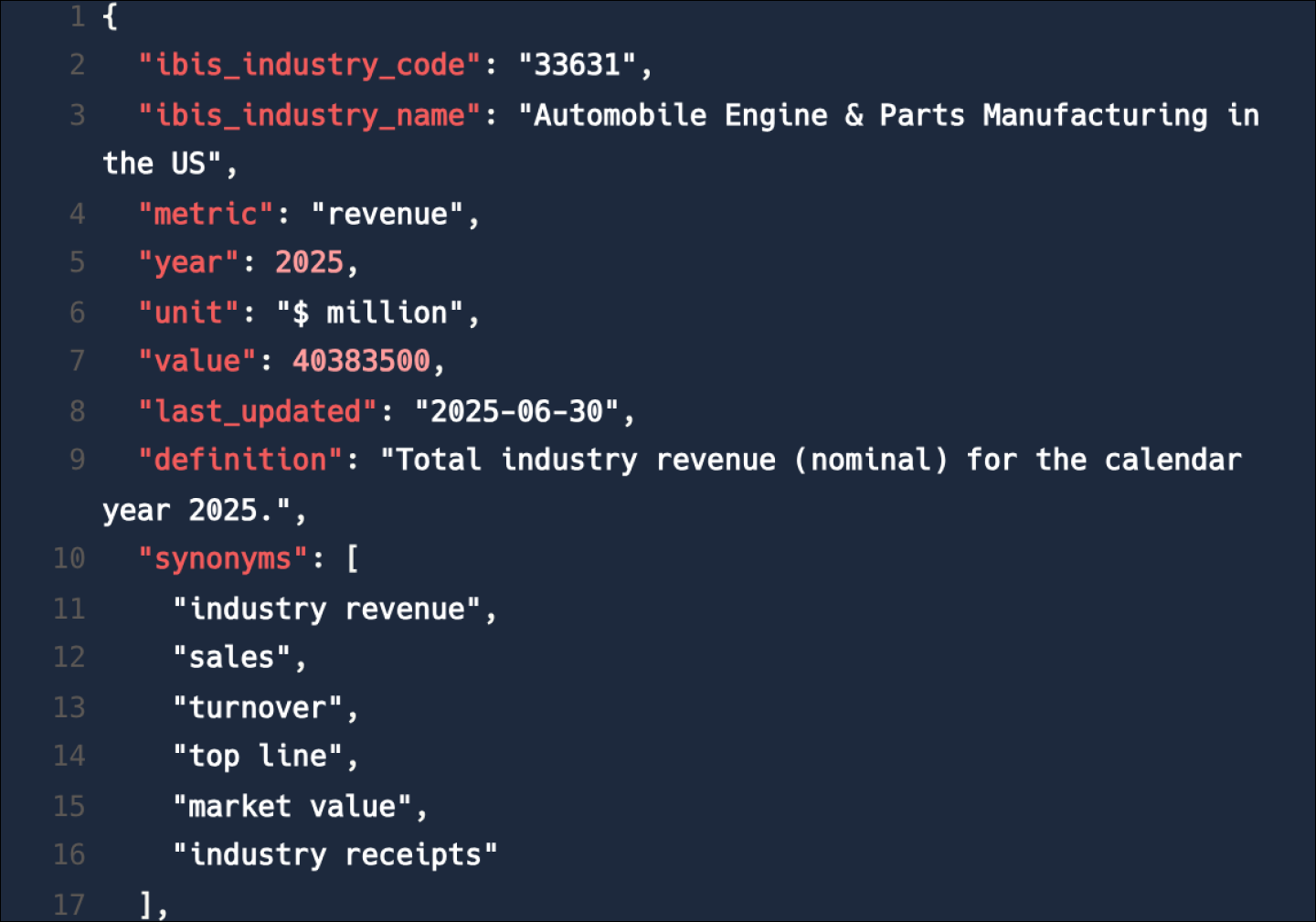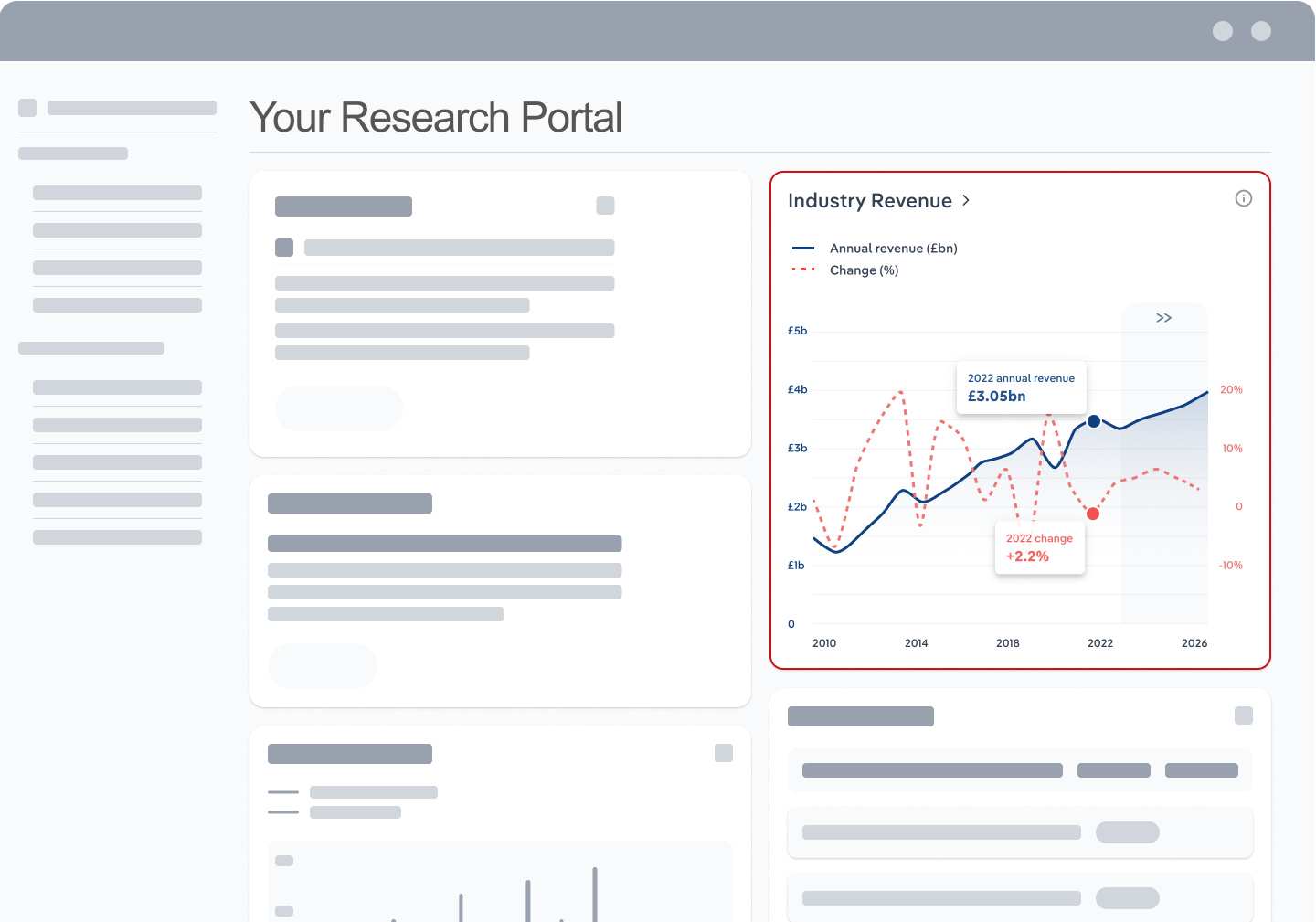Industry Statistics and Trends
Market size and recent performance (2015-2030)
Industry revenue has grown at a CAGR of 0.9 % over the past five years, to reach an estimated $9.7bn in 2025.
Trends and Insights
Falling iron ore prices are dampening structural steel fabrication’s performance
- Iron ore prices spiked significantly in 2022, reaching around $219.00 per tonne, driven by strong global demand and supply constraints. However, as at December 2024, prices have dropped considerably, hovering around $105.00 per tonne, and reducing by approximately 23% since the beginning of the year. This decline is primarily down to weakening demand from China, particularly in its real estate sector, which accounts for about 40% of steel demand. With this market wavering, there’s an oversupply in the global market, driving down prices.
- Additional trends and insights available with purchase
Industry outlook (2025-2030)
Market size is projected to decline over the next five years.
Trends and Insights
The core building markets are set to offer favourable conditions for structural steel products
- Structural steel fabricators will likely benefit from a resurgence in residential and non-residential construction over the coming years as mounting population pressures and historically low rental vacancy rates support construction activity. High-rise apartment developments require large quantities of rolled steel framework and concrete reinforcement products, so modern inner-city living trends will support demand for the industry.
Biggest companies in the Structural Steel Fabricating in Australia
| Company | Market Share (%)
2025 | Revenue ($m)
2025 |
|---|---|---|
InfraBuild | 2,101.0 | |
BlueScope Steel | 2,042.5 | |
Civmec | 341.4 |
To view the market share and analysis for all 7 top companies in this industry, view purchase options.
Products & Services Segmentation
Industry revenue is measured across several distinct product and services lines, including Rolled-formed structural framework, Reinforcing rods and bars and Reinforcing mesh and wire. Rolled-formed structural framework is the largest segment of the Structural Steel Fabricating in Australia.
Trends and Insights
Prefabrication trends have supported rising demand for rolled-formed structural products
- The industry generates its largest share of revenue from rolled-formed structural framework products, including steel beams, joists and girders, which are vital components in many building and infrastructure projects.
- More insights available in the full report
Table of Contents
About this industry
Industry definition
The Australian structural steel fabrication industry involves the design, manufacture, and supply of structural steel products used in construction projects. This includes the production of beams, columns, frames, and other steel components essential for building infrastructure, commercial, and industrial structures. The industry serves sectors like non-residential, residential, and infrastructure construction, providing critical materials for structural integrity.
What's included in this industry?
Products and services covered in the Structural Steel Fabricating industry in Australia include Rolled-formed structural framework , Reinforcing rods and bars, Reinforcing mesh and wire, Prefabricated steel scaffolding, plate work and modular bridge sections, Prefabricated steel towers and lattice masts and Customised engineered fabricated structural steel products.Companies
Companies covered in the Structural Steel Fabricating industry in Australia include InfraBuild, BlueScope Steel and Civmec.Purchase this report to view all 7 major companies in this industry.
Related Terms
Related terms covered in the Structural Steel Fabricating industry in Australia include joists, girders and trusses.Industry Code
ANZSIC 2221 - Structural Steel Fabricating in Australia
Performance
Get an indication of the industry's health through historical, current and forward-looking trends in the performance indicators that make or break businesses.
Analyst insights
Falling iron ore prices create opportunities but highlight broader challenges. While lower input costs ease raw material expenses for fabricators, weaker construction activit...
In this chapter (4)
- Current Performance
- Outlook
- Volatility
- Life Cycle
Key metrics
- Annual Revenue, Recent Growth, Forecast, Revenue Volatility
- Number of Employees, Recent Growth, Forecast, Employees per Business, Revenue per Employee
- Number of Businesses, Recent Growth, Forecast, Employees per Business, Revenue per Business
- Total Profit, Profit Margin, Profit per Business
Charts
- Revenue, including historical (2015-2024) and forecast (2025-2030)
- Employees, including historical (2015-2024) and forecast (2025-2030)
- Businesses, including historical (2015-2024) and forecast (2025-2030)
- Profit, including historical (2015-2025)
- Industry Volatility vs. Revenue Growth
- Industry Life Cycle
Detailed analysis
- Trends in supply, demand and current events that are driving current industry performance
- Expected trends, economic factors and ongoing events that drive the industry's outlook
- Key success factors for businesses to overcome volatility
- How contribution to GDP, industry saturation, innovation, consolidation, and technology and systems influence the industry's life cycle phase.
Products and Markets
Learn about an industry's products and services, markets and trends in international trade.
Analyst insight
Sustainability initiatives and existing infrastructure temper demand for steel in the mining sector. Resource companies are prioritising electrification and ESG compliance, w...
In this chapter
- Products & Services
- Major Markets
- International Trade
Key metrics
- Largest market segment and value in 2025
- Product innovation level
- Total imports, level and trend
- Total exports, level and trend
- Trade Balance
Charts
- Products & services segmentation in 2025
- Major market segmentation in 2025
- International trade, including imports by country and exports by country
Detailed analysis
- Trends impacting the recent performance of the industry's various segments
- Innovations in the industry's product or service offering, specialization or delivery method
- Key factors that successful businesses consider in their offerings
- Buying segments and key trends influencing demand for industry products and services
- Recent trends in import and export volumes, country of origin or destination, and expected future trends
Geographic Breakdown
Discover where business activity is most concentrated in an industry and the factors driving these trends to find opportunities and conduct regional benchmarking.
Analyst insights
Queensland and Western Australia see disproportionate activity in structural steel fabrication relative to their population. These states have substantial infrastructure cons...
In this chapter (1)
- Business Locations
Charts
- Share of revenue, establishment, wages and employment in each region
- Share of population compared to establishments in each region in 2025
Tables
- Number and share of establishments in each region in 2025
- Number and share of revenue each region accounts for in 2025
- Number and share of wages each region accounts for in 2025
- Number and share of employees in each region in 2025
Detailed analysis
- Geographic spread of the industry across Asia Pacific, and trends associated with changes in the business landscape
- Key success factors for businesses to use location to their advantage
Competitive Forces
Get data and insights on what's driving competition in an industry and the challenges industry operators and new entrants may face, with analysis built around Porter's Five Forces framework.
Analyst insights
Fabricators face intense internal competition, striving to provide cost-effective solutions and specialised products and services. While top players like BlueScope Steel and ...
In this chapter (4)
- Concentration
- Barriers to Entry
- Substitutes
- Buyer & Supplier Analysis
Key metrics
- Industry concentration level
- Industry competition level and trend
- Barriers to entry level and trend
- Substitutes level and trend
- Buyer power level and trend
- Supplier power level and trend
Charts
- Market share concentration among the top 4 suppliers from 2020-2025
- Supply chain including upstream supplying industries and downstream buying industries, flow chart
Detailed analysis
- Factors impacting the industry’s level of concentration, such as business distribution, new entrants, or merger and acquisition activity.
- Key success factors for businesses to manage the competitive environment of the industry.
- Challenges that potential industry entrants face such as legal, start-up costs, differentiation, labor/capital intensity and capital expenses.
- Key success factors for potential entrants to overcome barriers to entry.
- Competitive threats from potential substitutes for the industry’s own products and services.
- Key success factors for how successful businesses can compete with substitutes.
- Advantages that buyers have to keep favorable purchasing conditions.
- Advantages that suppliers have to maintain favorable selling conditions.
- Key success factors for how businesses can navigate buyer and supplier power.
Companies
Learn about the performance of the top companies in the industry.
Analyst insights
Steel giants BlueScope and Liberty InfraBuild hold sway in the Structural Steel Fabrication industry. These vertically integrated manufacturers supply an impressive portfolio...
In this chapter
- Market Share Concentration
- Companies
- Company Spotlights
Charts
- Industry market share by company in 2021 through 2025
- Major companies in the industry, including market share, revenue, profit and profit margin in 2025
- Overview of InfraBuild's performance by revenue, market share and profit margin from 2019 through 2025
- Overview of BlueScope Steel's performance by revenue, market share and profit margin from 2019 through 2025
- Overview of Civmec's performance by revenue, market share and profit margin from 2019 through 2025
- Overview of revenue, market share and profit margin trend for 4 additional companies
Detailed analysis
- Description and key data for InfraBuild, and factors influencing its performance in the industry
- Description and key data for BlueScope Steel, and factors influencing its performance in the industry
- Description and key data for Civmec, and factors influencing its performance in the industry
- Description, key data and performance trends for 4 additional companies
External Environment
Understand the demographic, economic and regulatory factors that shape how businesses in an industry perform.
Analyst insights
Governments across all levels enforce numerous regulations on the Structural Steel Fabricating industry. These cover zoning laws and workers' safety measures imposed by local...
In this chapter
- External Drivers
- Regulation & Policy
- Assistance
Key metrics
- Regulation & policy level and trend
- Assistance level and trend
Charts
- Regulation & Policy historical data and forecast (2015-2030)
- Assistance historical data and forecast (2015-2030)
Detailed analysis
- Demographic and macroeconomic factors influencing the industry, including Regulation & Policy and Assistance
- Major types of regulations, regulatory bodies, industry standards or specific regulations impacting requirements for industry operators
- Key governmental and non-governmental groups or policies that may provide some relief for industry operators.
Financial Benchmarks
View average costs for industry operators and compare financial data against an industry's financial benchmarks over time.
Analyst insights
Profit margins are under pressure from rising costs and imported steel competition. Imported fabricated steel is less costly than local alternatives, creating downwards prici...
In this chapter
- Cost Structure
- Financial Ratios
- Key Ratios
Key metrics
- Profit margin, and how it compares to the sector-wide margin
- Average wages, and how it compares to the sector-wide average wage
- Largest cost component as a percentage of revenue
- Industry average ratios for days' receivables, industry coverage and debt-to-net-worth ratio
Charts
- Average industry operating costs as a share of revenue, including purchases, wages, depreciation, utilities, rent, other costs and profit in 2025
- Average sector operating costs as a share of revenue, including purchases, wages, depreciation, utilities, rent, other costs and profit in 2025
- Investment vs. share of economy
Data tables
- Cash Flow & Debt Service Ratios (2015-2030)
- Revenue per Employee (2015-2030)
- Revenue per Enterprise (2015-2030)
- Employees per Establishment (2015-2030)
- Employees per Enterprise (2015-2030)
- Average Wage (2015-2030)
- Wages/Revenue (2015-2030)
- Establishments per Enterprise (2015-2030)
- IVA/Revenue (2015-2030)
- Imports/Demand (2015-2030)
- Exports/Revenue (2015-2030)
Detailed analysis
- Trends in the cost component for industry operators and their impact on industry costs and profitability
Key Statistics
Industry Data
Data Tables
Including values and annual change:
- Revenue (2015-2030)
- IVA (2015-2030)
- Establishments (2015-2030)
- Enterprises (2015-2030)
- Employment (2015-2030)
- Exports (2015-2030)
- Imports (2015-2030)
- Wages (2015-2030)
Top Questions Answered
Unlock comprehensive answers and precise data upon purchase. View purchase options.
What is the market size of the Structural Steel Fabricating industry in Australia in 2025?
The market size of the Structural Steel Fabricating industry in Australia is $9.7bn in 2025.
How many businesses are there in the Structural Steel Fabricating industry in Australia in 2025?
There are 1,989 businesses in the Structural Steel Fabricating industry in Australia, which has grown at a CAGR of 1.1 % between 2020 and 2025.
How may import tariffs affect the Structural Steel Fabricating industry in Australia?
The Structural Steel Fabricating industry in Australia is likely to be impacted by import tariffs with imports accounting for a moderate share of industry revenue.
How may export tariffs affect the Structural Steel Fabricating industry in Australia?
The Structural Steel Fabricating industry in Australia is unlikely to be materially impacted by export tariffs with exports accounting for a low share of industry revenue.
Has the Structural Steel Fabricating industry in Australia grown or declined over the past 5 years?
The market size of the Structural Steel Fabricating industry in Australia has been growing at a CAGR of 0.9 % between 2020 and 2025.
What is the forecast growth of the Structural Steel Fabricating industry in Australia over the next 5 years?
Over the next five years, the Structural Steel Fabricating industry in Australia is expected to decline.
What are the biggest companies in the Structural Steel Fabricating industry in Australia?
The biggest companies operating in the Structural Steel Fabricating industry in Australia are InfraBuild, BlueScope Steel and Civmec
What does the Structural Steel Fabricating industry in Australia include?
Rolled-formed structural framework and Reinforcing rods and bars are part of the Structural Steel Fabricating industry in Australia.
Which companies have the highest market share in the Structural Steel Fabricating industry in Australia?
The company holding the most market share in the Structural Steel Fabricating industry in Australia is InfraBuild.
How competitive is the Structural Steel Fabricating industry in Australia?
The level of competition is high and increasing in the Structural Steel Fabricating industry in Australia.
Methodology
How are IBISWorld reports created?
IBISWorld has been a leading provider of trusted industry research for over 50 years to the most successful companies worldwide. With offices in Australia, the United States, the United Kingdom, Germany and China, we are proud to have local teams of analysts that conduct research, data analysis and forecasting to produce data-driven industry reports.
Our analysts start with official, verified and publicly available sources of data to build the most accurate picture of each industry. Analysts then leverage their expertise and knowledge of the local markets to synthesize trends into digestible content for IBISWorld readers. Finally, each report is reviewed by one of IBISWorld’s editors, who provide quality assurance to ensure accuracy and readability.
IBISWorld relies on human-verified data and human-written analysis to compile each standard industry report. We do not use generative AI tools to write insights, although members can choose to leverage AI-based tools within the platform to generate additional analysis formats.
What data sources do IBISWorld analysts use?
Each industry report incorporates data and research from government databases, industry-specific sources, industry contacts, and our own proprietary database of statistics and analysis to provide balanced, independent and accurate insights.
Key data sources in Australia include:
- Australian Bureau of Statistics
- Australian Taxation Office
- Australian Securities & Investments Commission
Analysts also use industry specific sources to complement catch-all sources, although their perspective may focus on a particular organization or representative body, rather than a clear overview of all industry operations. However, when balanced against other perspectives, industry-specific sources provide insights into industry trends.
These sources include:
- Industry and trade associations
- Industry federations or regulators
- Major industry players annual or quarterly filings
Finally, IBISWorld’s global data scientists maintain a proprietary database of macroeconomic and demand drivers, which our analysts use to help inform industry data and trends. They also maintain a database of statistics and analysis on thousands of industries, which has been built over our more than 50-year history and offers comprehensive insights into long-term trends.
How does IBISWorld forecast its data?
IBISWorld’s analysts and data scientists use the sources above to create forecasts for our proprietary datasets and industry statistics. Depending on the dataset, they may use regression analysis, multivariate analysis, time-series analysis or exponential smoothing techniques to project future data for the industry or driver. Additionally, analysts will leverage their local knowledge of industry operating and regulatory conditions to impart their best judgment on the forecast model.
IBISWorld prides itself on being a trusted, independent source of data, with over 50 years of experience building and maintaining rich datasets and forecasting tools. We are proud to be the keystone source of industry information for thousands of companies across the world.
Learn more about our methodology and data sourcing on the Help Center.










